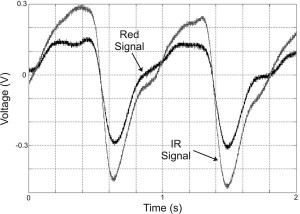An Ultra-low-power Pulse Oximeter Implemented with an Energy-efficient Transimpedance Amplifier
Pulse oximeters are ubiquitous in modern medicine for non-invasively measuring the percentage of oxygenated hemoglobin in a patient’s blood by comparing transmission characteristics of red and infrared LED light through the patient’s finger with a photoreceptor. We developed an analog single-chip pulse oximeter with 4.8-mW total power dissipation, which is an order of magnitude below our measurements on commercial implementations [1]. The majority of this power reduction is due to the use of a novel logarithmic transimpedance amplifier with inherent contrast sensitivity, distributed amplification, unilateralization, and automatic loop gain control. The transimpedance amplifier together with a photodiode current source form a high-performance photoreceptor with characteristics similar to those found in nature. Therefore, our oximeter is well suited for portable medical applications such as continuous home-care monitoring for elderly or chronic patients, emergency patient transport, remote soldier monitoring, and wireless medical sensing. Furthermore, our design obviates the need for an A-to-D and DSP and leads to a small single-chip solution.
- Figure 1: The architecture of our low-power pulse oximeter.
- Figure 2: Measured blood pulsation signals of a subject under study. These waveforms appear at the outputs of the two LPFs shown in our pulse oximeter system of Figure 1.
References
- M. Tavakoli, L. Turicchia, and R. Sarpeshkar, “An Ultra-Low-Power Pulse Oximeter Implemented with an Energy-Efficient Transimpedance Amplifier,” IEEE Transactions on Biomedical Circuits and Systems, vol. 4, no. 1, pp. 27-38, Feb. 2010. [↩]

